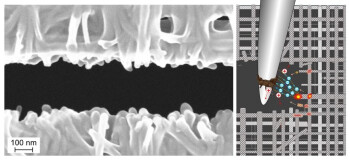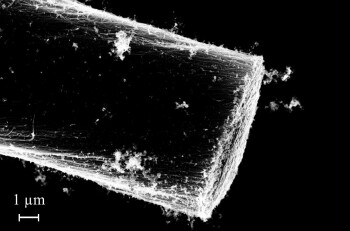Doctor of Science - Physics (Solid State Physics)
Heat Physics Department of Uzbek Academy of Science, USSR - 1992
-medium.jpg)
Ali Aliev
Research Professor - Nanotech Institute
Professional Preparation
Ph.D. - Physics (Molecular and Thermal Physics)
Heat Physics Department of Uzbek Academy of Science, USSR - 1984
Heat Physics Department of Uzbek Academy of Science, USSR - 1984
B.S.- M.S. - Electrical Engineering
National University of Radio-Electronics, Kharkov, Ukraine - 1977
National University of Radio-Electronics, Kharkov, Ukraine - 1977
Research Areas
Nanoscience and nanotechnology
- Phonon and electron transport in low-dimensional structures: Carbon Nanotubes, Graphene, Graphyne.
- Thermal properties of nanostructured materials
- Mirage effect on the surface of transparent carbon nanotube films: Modulation of refractive index of air and water, cloaking systems
- Nanostructured thermoelectrics and elastocaloric materials
- Dray-state patterning of nanostructured materials using field enhanced electron emission
Superconductivity in nanostructured transient metal oxides
- Superconductivity in nanostructured tungsten trioxide doped with sodium ions, Nax-WO 3
- Reversible superconductivity in doped (electrochromic) indium-tin oxide films
- Paramagnetic Meissner effect in electrochemically doped Indium-Tin Oxide films
Negative refraction in photonic crystals.
Thermoacoustic sound generation: in air and underwater.
- Energy conversion efficiency of open and closed thermoacoustic systems
- Nanostructured materials for thermophones
- Encapsulated thermoacoustic projectors: Search for high power and high efficiency
- Underwater thermoacoustic projectors
Publications
Probing Intercalated Indium-Tin Oxide Films by Non-Local Resistance Measurements 2024 - IEEE Transactions on Applied Superconductivity
Mechanical energy harvesters with tensile efficiency of 17.4% and torsional efficiency of 22.4% based on homochirally plied carbon nanotube yarns 2023 - Nature Energy
Scalable synthesis and characterization of multilayer γ-graphyne, new carbon crystals with a small direct bandgap 2022 - J. Am. Chem. Soc.
Spin-polarized plasmonics: fresh view on magnetic nanoparticles, Chapter in the book “Chirality, Magnetism and Magnetoelectricity” Ed. by E. Kamenetskii, 2021 - Book, Springer
Understanding the Low Frequency Response of Carbon Nanotube Thermoacoustic Projectors, 498, 114940, 2021 - J. Sound Vib.
Appointments
Research Professor
University of Texas at Dallas, Alan G. MacDiarmid Nanotech Institute [2004–Present]
University of Texas at Dallas, Alan G. MacDiarmid Nanotech Institute [2004–Present]
Research Scientist
University of California, Los Angeles, Electrical Engineering Department [2003–2004]
Multi-University Research Initiative (MURI) Program on “Electrochromic Adaptive Infrared Camouflage”. PI - E. Yablonovitch
University of California, Los Angeles, Electrical Engineering Department [2003–2004]
Multi-University Research Initiative (MURI) Program on “Electrochromic Adaptive Infrared Camouflage”. PI - E. Yablonovitch
Visiting Researcher
University of Texas at Dallas, Nanotech Institute [2002–2003]
DARPA project: “Thermal Conductivity Enhancement by Optical Phonon Sub-band Engineering of Nanostructures Based on C and BN nanotubes" P.I. Ray H. Baughman
University of Texas at Dallas, Nanotech Institute [2002–2003]
DARPA project: “Thermal Conductivity Enhancement by Optical Phonon Sub-band Engineering of Nanostructures Based on C and BN nanotubes" P.I. Ray H. Baughman
Invited Professor
LG-Electronics, Institute of Technology LG-Elite, Seoul, Korea [1998–2001]
PI of project: “Electrochromic Matrix Addressable Flat Panel Display”. Project was supported by Display Division of LG-Electronics.
LG-Electronics, Institute of Technology LG-Elite, Seoul, Korea [1998–2001]
PI of project: “Electrochromic Matrix Addressable Flat Panel Display”. Project was supported by Display Division of LG-Electronics.
Senior Researcher
Uzbek Academy of Sciences, Heat Physics Department, Tashkent, Uzbekistan [1984–2004]
The leading research investigator of project "Advanced superionic conductors" supported by Uzbek Academy of Sciences
Uzbek Academy of Sciences, Heat Physics Department, Tashkent, Uzbekistan [1984–2004]
The leading research investigator of project "Advanced superionic conductors" supported by Uzbek Academy of Sciences
Research Scientist
Uzbek Academy of Sciences, Heat Physics Department, Tashkent, Uzbekistan [1978–1983]
Uzbek Academy of Sciences, Heat Physics Department, Tashkent, Uzbekistan [1978–1983]
Engineer
Institute of Electronics, Academy of Sciences of Uzbekistan, Tashkent [1977–1978]
Development of high-temperature carbide materials for space shuttle
Institute of Electronics, Academy of Sciences of Uzbekistan, Tashkent [1977–1978]
Development of high-temperature carbide materials for space shuttle
Projects
Phonon engineering in low-dimensional nanostructures
2004/01Superconductivity in oxide materials
2005/01Thermo-Acoustic sound generation in air and underwater: New materials; High-Power Density Projectors, Efficiency consideration.
2017/07–2021/07News Articles
Electron Emission Patterning, Research Outreach, 2021, 121, p.88-91
 The demand for smaller and more powerful electronic devices is ever growing in many sectors of today’s society. Current technology limits how small devices can be. To develop smaller devices, new materials and manufacturing techniques are needed. Ali Aliev and Ray Baughman of the Alan G. MacDiarmid NanoTech Institute have developed a non-contact dry patterning technique for carbon nanotubes. Their technique uses field-enhanced electron emission to introduce patterns onto nanomaterials and allows for the fabrication of a variety of nanostructures useful for electronic and optical devices.
The demand for smaller and more powerful electronic devices is ever growing in many sectors of today’s society. Current technology limits how small devices can be. To develop smaller devices, new materials and manufacturing techniques are needed. Ali Aliev and Ray Baughman of the Alan G. MacDiarmid NanoTech Institute have developed a non-contact dry patterning technique for carbon nanotubes. Their technique uses field-enhanced electron emission to introduce patterns onto nanomaterials and allows for the fabrication of a variety of nanostructures useful for electronic and optical devices.
Non-contact patterning of nanomaterials in air by low-voltage electron-emission, Advances in Engineering, 2021
 The study by Professor Aliev and Professor Baughman reported the successful development of a dry-state patterning technique for freestanding or supported nanostructures. In a statement to Advances in Engineering, the authors explained the proposed electron emission patterning for processing of carbon and other conductive two- and three-dimensional nanostructures in air could be useful for integration of conductive electronic and optical devices into existing silicon planar technologies. Moreover, by using their technique, multi-electrode sensors, metamaterials, photonic crystals and various electronic components had been successfully fabricated. The innovative method invented by Professor Aliev and Professor Baughman is now under provisional Patent Application #20016P1, Dec.8, 2020 “A method and device for patterning nanomaterials”.
The study by Professor Aliev and Professor Baughman reported the successful development of a dry-state patterning technique for freestanding or supported nanostructures. In a statement to Advances in Engineering, the authors explained the proposed electron emission patterning for processing of carbon and other conductive two- and three-dimensional nanostructures in air could be useful for integration of conductive electronic and optical devices into existing silicon planar technologies. Moreover, by using their technique, multi-electrode sensors, metamaterials, photonic crystals and various electronic components had been successfully fabricated. The innovative method invented by Professor Aliev and Professor Baughman is now under provisional Patent Application #20016P1, Dec.8, 2020 “A method and device for patterning nanomaterials”.